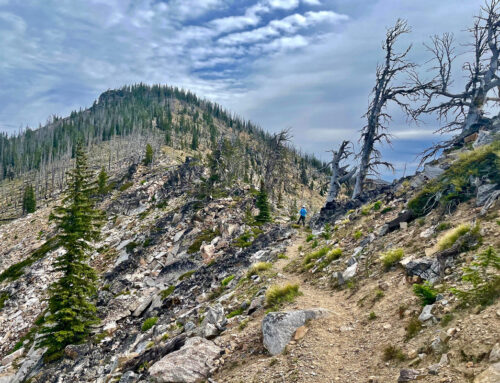Earlier this summer, ITA, in partnership with the Payette National Forest Heritage Program, helped complete a survey of the historic Three Blaze Trail in the Frank Church- River of No Return Wilderness. The Three Blaze Trail was built in 1902 during the Gold Rush days to connect the mining town of Dixie, Idaho with the Thunder Mountain mining district over 90 miles of rugged terrain. Many miners traveled the route in hopes of finding gold and becoming rich.

In late May, ITA volunteers and experienced hikers John Platt, Art Troutner, and Dave Beck spent three days in the Campbell’s Ferry area mapping traces of the old trail and documenting any artifacts found along the way. Portions of the Three Blaze trail are still maintained and in use for recreational purposes but other parts of the trail have been completely lost. Many forest fires over the years have obscured the route and made it hard to find the iconic “three blazes” along the trail. These were trail markers cut with axes into trees along the way to guide travelers.

The surveys that ITA helped complete in 2019 and 2020 are part of a larger study into the Thee Blaze Trail. Morgan Zedalis, the Assistant Forest Archaeologist for the Payette National Forest’s Heritage Program explained how the areas around Campbell’s Ferry and Chamberlain Basin where the ITA volunteers surveyed were probably some of the harder portions of the trail route to try to identify. The three volunteers were working with hand-drawn maps for some of the areas without a scale to try to find the way.
When asked why this survey was significant for the Heritage Program, Morgan explained, “I think it’s important to document the stories and the lives of people that contributed to the settlement of Idaho and to our current sense of identity and who we are as Americans. I think it’s really important because once those stories and the remains of those stories on the landscape are gone, they’re hard to get back.” Morgan believes that the history of the trail goes back much further than just to Idaho’s mining days. Many historic trails like this one were likely once Native American travel routes.
By the end of the trip, the crew was able to connect the potions of the trail that the ITA volunteers surveyed last year with the trail they identified on this trip. One exciting outcome was the crew was able to find the route with some certainty along Little Trout Creek which was previously unknown. While the going was hard in many spots, the crew was excited to be walking where so much history had previously taken place.

“You can’t really grasp the hardships that our forefathers dealt with until you ‘walk a mile in their shoes.’” explained ITA volunteer John Platt. “I think it’s cool to imagine what life was like back then. REAL wilderness, where man was an ignorant intruder. Or blissful explorer. I’m amazed at the work and effort it took to know the lay of the land well enough to create such a trail. Remember, there were no maps. And the area is fantastically rugged.”
Morgan hopes that this survey will lead to big things for the trail. The Heritage Program is planning to nominate the trail for the National Register of Historic Properties and possibly even apply for a National Trail designation.

If you’d like to walk a mile in a miner’s shoes, portions of the Three Blaze Trail are maintained and make for a great hiking adventure. Monumental Creek Trail, Ramey Ridge Trail, and a segment called the Three Blaze Trail are all great options. The portion called the Three Blaze Trail is located right outside of the Chamberlain Basin area and there you can still see some trees with the three blazes on them. If you’d like to learn more about John, Art, and Dave’s trip as well as more of the history of the trail from Morgan, check out our webinar December 3 at 7pm MT about the Three Blaze Trail.





Great article about a great surveying job. Good work John, Art and Dave.
This is a really interesting project. Thanks for the work, and the article!
thanks for all your hard work!!
Commendable effort a veritable Dream Team of modern-day explorers
Great article! I missed the zoom presentation. Any way to find it on your site?
Thanks!
My wife’s great grandparents owned the store in Stites that was the Gateway to Thunder Mountain in 1902 and supplied many of the miners who took the 3 blazes trail. So this was of special interest to us.